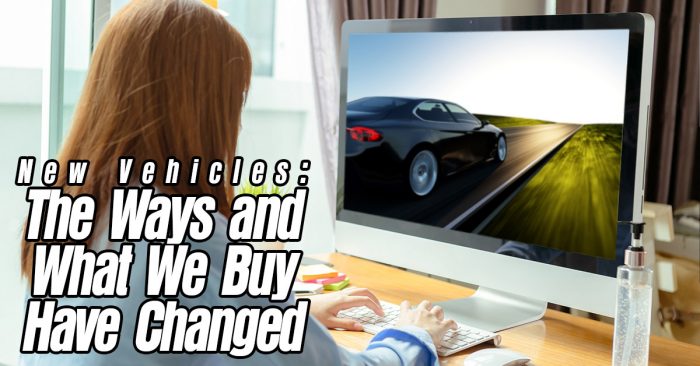New Vehicles: The Ways and What We Buy Have Changed
New Vehicles: The Ways and What We Buy Have Changed

New Vehicles: The Ways and What We Buy Have Changed
If you haven’t purchased a brand new car in a while, you may be surprised to learn how the process and available choices have changed. Families would often plan an entire weekend for visiting car dealers, taking test drives and the ever-popular negotiation process. Looking back, the process has changed fairly dramatically over the past decade or two, prompted by consumer demand, technology, convenience, and to some degree, the pandemic.
Here’s a look at how things have changed.
A shrinking popularity of passenger cars. As recently as 2012, passenger cars accounted for more than 50% of vehicle sales. Now cars account for only 22% of new car sales, dropping 5% worldwide in model year 2019 alone. SUV’s, vans and pickup trucks account for the remaining 78%.
Disappearing brands. Changing consumer demand has forced some car companies to just go away. These include Oldsmobile, Pontiac, Saturn and Mercury. Of course, along with the brands, models like the Cougar, Sunbird, Firebird and Cutlass are no longer available as new models.
Stick-shift? What’s a stick-shift? The number of cars available with a manual transmission are shrinking as well. As of 2020, only 41 of 327 new car models available in the United States that were available could be purchased with a manual transmission.
The growing list of “standard features”. Today, most car models featured what were once options as standard equipment. These include power locks and windows, air conditioning and air bags. Even rearview cameras are now becoming standard.
The presence of infotainment systems. Those who haven’t purchased a new car for many years are often surprised by the technology available and the robust infotainment features vehicles now have. Plan on spending some time with that owner’s manual.
How vehicles are purchased. Rather than trekking to a new car dealer, many consumers now purchase cars virtually. They will view vehicles, select options, fill out financing forms and order it, all online. Some will even go a step further and have the car delivered to their home.
Negotiating. Since the internet has made price comparisons so easy, many car dealers have turned to flat, “no-haggle” pricing. This simply means the price listed is the price you pay. Be careful to read the fine print about dealer fees and other charges, however. Some will miss the “dance” between buyers, salesmen and, of course, “the new car manager.”
When purchasing a new or a pre-owned car, be sure to check its impact on your insurance rates prior to your purchase. Differing years and models are some of the factors that will impact pricing. Knowing the impact ahead of time can keep you within your budget. Contact one of our independent insurance agents and have them do the shopping for you. They have the ability to compare policies from multiple companies. Contact us today!
![[COMPANY]](https://2.websitesbyica.com/wp-content/uploads/2018/10/agent-logo.png)









